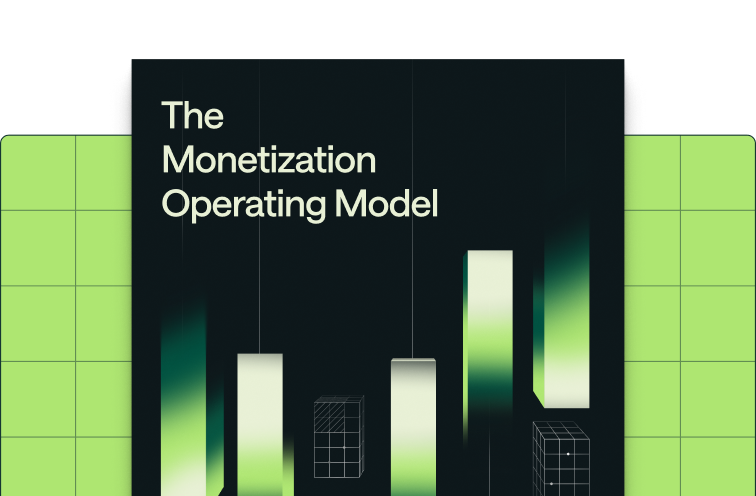Share
Dynamic pricing eliminates the revenue lag between value delivery and pricing adjustments. It does this by decoupling pricing logic from product code and enabling real-time rate updates through centralized pricing catalogs.
In contrast, static pricing uses fixed rates that remain consistent over time periods — whether that's daily, monthly, or annually.
Both approaches serve different business needs. For example, dynamic pricing works well when value correlates directly with usage or market conditions change frequently. Static pricing, on the other hand, provides predictability for customers and simplified operations.
{{widget-monetization-whitepaper}}What is dynamic pricing?
Dynamic pricing is a pricing strategy that automatically adjusts rates in real-time based on market conditions, demand signals, customer usage patterns, or other variable factors.
Unlike static pricing that remains fixed over set periods, dynamic pricing lets companies respond immediately to changing conditions without manual intervention or tons of engineering work.
There are two main approaches for dynamic pricing:
- Automated, real-time dynamic pricing
- Operationally agile dynamic pricing
Both approaches solve the same fundamental problem: static pricing can't always keep up with dynamic value delivery.
Automated, real-time dynamic pricing
Real-time dynamic pricing adjusts immediately and algorithmically based on live signals like demand spikes, competitor pricing changes, or time-based rules. Changes are automated, meaning they happen in seconds or minutes without human intervention.
This approach is common in marketplaces and consumer platforms.
Here are some examples of companies using real-time dynamic pricing:
- Uber's surge pricing responds to supply and demand imbalances instantly.
- Amazon adjusts millions of prices daily using algorithmic optimization across demand, competition, and inventory signals.
- Airlines have mastered complex real-time pricing across routes, timing, and customer segments through sophisticated revenue management.
Real-time systems require sophisticated infrastructure for automation, trust mechanisms, and risk mitigation.
For example, pricing needs to be transparent so that customers understand when and why prices change — especially when they’re charged more. Automated pricing also needs safety controls to prevent pricing errors that could damage relationships or revenue.
Operationally agile dynamic pricing
Operationally agile pricing can be updated rapidly in days or weeks in response to business needs with little to no engineering effort. This approach focuses on infrastructure flexibility, modular pricing logic, and clean data pipelines for fast iteration.
B2B SaaS and usage-based companies typically use this model. Here are some examples:
- OpenAI iterates pricing for new models rapidly, adjusting token costs based on compute efficiency and demand patterns without engineering bottlenecks.
- Stripe continuously refines pricing across different payment products and geographies based on usage data and market feedback.
- Snowflake adapts compute and storage pricing quickly to reflect technology improvements and competitive positioning.
While they aren’t automated, operationally agile systems enable business teams to iterate pricing independently from engineering cycles.
This means product teams can test new monetization strategies, finance teams can respond to competitive moves, and customer success teams can adjust pricing based on usage patterns.
How dynamic pricing works
Dynamic pricing operates through three core components:
- Data collection
- Pricing logic
- Execution infrastructure
The emphasis differs based on whether you're implementing real-time automation or operational agility.
Data collection drives pricing decisions
For automated systems, data collection captures live signals like demand fluctuations, competitive prices, inventory levels, and customer behavior in real-time. Algorithms process these signals instantly to determine optimal pricing.
Operationally agile systems focus on usage patterns, customer feedback, competitive analysis, and business performance metrics. Teams analyze this data to make informed pricing adjustments through rapid manual processes.
Both approaches require clean, reliable data pipelines. You can't make good pricing decisions with bad data, whether those decisions happen automatically or manually.
Pricing logic translates data into rates
Real-time systems process signals through algorithms or rules to determine optimal pricing instantly. Machine learning models might optimize across multiple variables simultaneously. Time-based rules might adjust rates during peak periods.
Operationally agile systems enable rapid manual adjustments, A/B testing, and iterative pricing experiments. Business teams can adjust different components like tiers, features, or usage rates without touching code.
The key is modular pricing logic that can be updated quickly and safely. Changes should be reversible. Testing should be possible before full deployment.
Execution infrastructure applies changes
Automated systems apply pricing changes across all customer touchpoints within seconds. This requires robust infrastructure that can handle instant updates without breaking customer experiences.
Operationally agile systems allow business teams to deploy pricing changes quickly without engineering dependencies. Changes should take effect instantly for the desired cohort, much faster than traditional quarterly reviews.
Feedback loops measure performance
Both approaches measure pricing performance and customer response to inform future adjustments. Real-time systems emphasize automated optimization based on immediate signals. Agile systems focus on strategic iteration based on business outcomes.
Effective feedback loops answer key questions: Did the pricing change achieve its intended goal? How did customers respond? What should we adjust next time?
Types of dynamic pricing models
Dynamic pricing models vary based on automation level, data sources, and business objectives. Most successful implementations combine multiple model types based on different use cases.
Real-time, automated models
There are four main types of real-time, automated dynamic pricing models:
Time-based pricing adjusts rates automatically during peak periods, off-peak periods, or promotional windows.
For example, airlines charge more for flights during busy travel seasons, and ride-sharing services increase prices during high-demand periods.
Demand-based pricing responds instantly to usage spikes, capacity constraints, or market demand signals.
You see this when cloud providers adjust compute pricing based on available capacity. Or when e-commerce sites change prices based on inventory levels.
Competitive pricing monitors competitor rates and adjusts positioning automatically. For example, some retailers track competitor prices and adjust their own rates to maintain specific margin or market position targets.
Algorithmic pricing uses machine learning to optimize across multiple variables simultaneously. These systems consider demand, competition, inventory, seasonality, and customer behavior to determine optimal prices.
Operationally agile models
There are also four main types of operationally agile dynamic pricing models:
Value-based dynamic pricing links price to delivered outcomes, usage efficiency, or customer success metrics through rapid iteration. Companies can quickly test different ways of capturing value as their products evolve.
Experimental pricing enables A/B testing different price points across customer segments. Teams can run controlled experiments to understand price sensitivity and optimize conversion rates.
Feature-based pricing allows quick bundling and unbundling of capabilities based on market feedback. Product teams can adjust which features are included in different tiers as they learn what customers value most.
Usage-tier optimization adjusts pricing bands based on customer adoption patterns. Companies can modify usage thresholds and rates as they understand actual consumption patterns better.
Hybrid approaches
The most sophisticated companies combine both methods, using real-time automation for tactical adjustments while maintaining operational agility for strategic pricing changes.
For example, a SaaS company might use automated rules to adjust prices based on usage tiers while maintaining manual control over strategic decisions like entering new markets or responding to major competitive moves.
Benefits of dynamic pricing
Dynamic pricing solves three core problems that hold back revenue growth: pricing lag, value misalignment, and competitive blind spots.
Revenue capture improves through real-time market response. Fixed pricing leaves money on the table during high-demand periods and prices out customers when demand drops. Dynamic pricing adjusts to market conditions, capturing maximum value across different scenarios without manual intervention.
Customer value alignment builds trust and reduces churn. Static pricing forces customers to pay based on assumptions rather than actual usage or outcomes. When pricing reflects what customers actually get, they understand the value exchange and stay longer.
Competitive advantage comes from speed, not complexity. Traditional pricing changes take months of analysis, approvals, and implementation. Dynamic pricing enables rapid response to market shifts, new competitors, or pricing pressure - adjusting within hours instead of quarters.
Pricing experimentation accelerates revenue optimization. Teams can test new models, measure results, and implement successful changes quickly. This data-driven approach replaces guesswork with systematic improvement.
Market expansion happens without infrastructure constraints. The same product can serve different segments, geographies, or use cases with appropriate pricing for each market - no custom development required.
Risk reduction through controlled rollouts. Gradual deployment, automatic rollbacks, and granular control over pricing changes let teams test with small customer segments before broader implementation.
The key advantage over static pricing is velocity - pricing changes can match product development cycles rather than waiting for quarterly reviews.
How to implement dynamic pricing
Successful dynamic pricing implementation requires choosing the right approach for your business model and building appropriate infrastructure foundations.
For real-time dynamic pricing
Start with automation infrastructure that can handle instant updates, real-time data processing, and automated risk controls. Systems must process thousands of pricing decisions without human intervention.
Define algorithmic triggers based on demand signals, competitive moves, or capacity constraints. Rules should be clear, testable, and include appropriate safety limits.
Build trust mechanisms through transparent pricing communication and predictable customer experiences. Customers need to understand when and why prices change.
Implement safety controls with automatic rollbacks, pricing floors and ceilings, and anomaly detection. Automated systems need guardrails to prevent pricing errors.
For operationally agile dynamic pricing
Build flexible pricing infrastructure that enables business teams to make changes without engineering dependencies. Pricing logic should be configurable through user interfaces or APIs.
Establish rapid iteration processes with approval workflows, testing capabilities, and performance monitoring. Changes should be safe, reversible, and measurable.
Create modular pricing logic that allows quick adjustments to different components like tiers, features, or usage rates. Components should work independently but connect seamlessly.
Develop clean data pipelines that provide pricing teams with accurate, timely usage and performance data. Good pricing decisions require good data.
Universal implementation steps
Establish pricing governance with clear ownership, approval processes, and rollback capabilities. Someone needs to own pricing strategy and execution.
Create customer transparency through usage dashboards, price notifications, and clear billing communication. Customers should understand what they're paying and why.
Measure and iterate with robust analytics, A/B testing capabilities, and feedback loops to continuously improve pricing performance. Dynamic pricing is an ongoing process, not a one-time implementation.
Companies that master pricing velocity
The most successful companies treat pricing changes like product deployments: fast, safe, and data-driven. Different approaches work for different business models, but the underlying principles are consistent.
Real-time leaders set the standard
Uber pioneered surge pricing that responds to supply and demand imbalances instantly while maintaining transparent customer communication. The system adjusts prices automatically but explains changes clearly to riders.
Amazon adjusts millions of prices daily using algorithmic optimization across demand, competition, and inventory signals. The scale requires sophisticated automation, but the results drive significant revenue optimization.
Airlines have mastered complex real-time pricing across routes, timing, and customer segments through sophisticated revenue management. These systems consider dozens of variables to optimize revenue per flight.
Operationally agile pioneers
OpenAI iterates pricing for new models rapidly, adjusting token costs based on compute efficiency and demand patterns without engineering bottlenecks. The team can respond to market feedback and cost changes quickly.
Leading fintech companies continuously refine pricing across different payment products and geographies based on usage data and market feedback. Changes happen regularly without major operational overhead.
Snowflake adapts compute and storage pricing quickly to reflect technology improvements and competitive positioning. The team can test new pricing models and deploy successful changes fast.
Shared infrastructure principles
These companies share common infrastructure capabilities: real-time data processing, flexible pricing engines, and rapid deployment systems. The competitive advantage comes from pricing agility whether through automation or operational speed.
They separate pricing logic from engineering constraints. Business teams can make pricing decisions without waiting for development cycles. Changes deploy safely with appropriate testing and rollback capabilities.
They invest in customer transparency and trust. Dynamic pricing works when customers understand and accept pricing changes. Communication, visibility, and predictability matter as much as the pricing algorithms.
Turn pricing into your competitive edge
Dynamic pricing represents a fundamental shift from reactive to proactive monetization.
The companies that succeed long-term implement dynamic pricing as a tactical improvement and build it as core infrastructure that evolves alongside their products.
Dynamic pricing creates monetization systems that connect product usage, pricing logic, and billing execution in real time. This requires the right combination of technology, processes, and organizational alignment.
Whether you choose real-time automated pricing or operationally agile approaches, success depends on three foundational elements: clean data pipelines that capture true value signals, flexible pricing infrastructure that separates business logic from engineering constraints, and transparent customer experiences that build trust through predictable communication.
Ready to dive deeper into building a complete monetization system? Our comprehensive whitepaper "The Monetization Operating Model" explores how leading companies are building infrastructure to support dynamic pricing at scale.
Sign up for early access to get practical frameworks.
The future belongs to companies that can price as dynamically as they ship features. Dynamic pricing, powered by the right operating model, makes that future possible today.
{{widget-monetization-whitepaper}}










